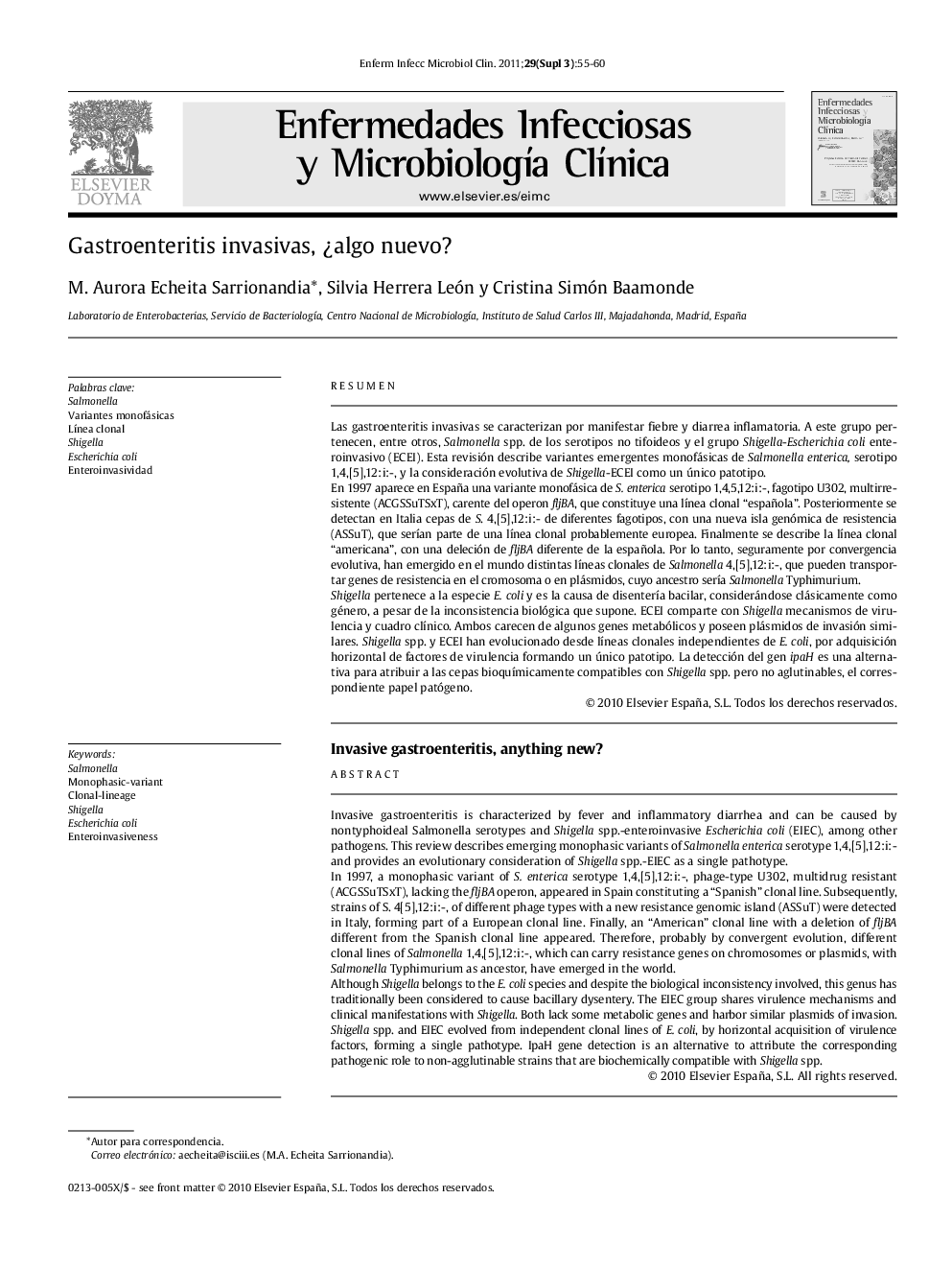| کد مقاله | کد نشریه | سال انتشار | مقاله انگلیسی | نسخه تمام متن |
|---|---|---|---|---|
| 3401920 | 1222690 | 2011 | 6 صفحه PDF | دانلود رایگان |

ResumenLas gastroenteritis invasivas se caracterizan por manifestar fiebre y diarrea inflamatoria. A este grupo pertenecen, entre otros, Salmonella spp. de los serotipos no tifoideos y el grupo Shigella-Escherichia coli enteroinvasivo (ECEI). Esta revisión describe variantes emergentes monofásicas de Salmonella enterica, serotipo 1,4,[5],12:i:-, y la consideración evolutiva de Shigella-ECEI como un único patotipo.En 1997 aparece en España una variante monofásica de S. enterica serotipo 1,4,5,12:i:-, fagotipo U302, multirresistente (ACGSSuTSxT), carente del operon fljBA, que constituye una línea clonal “española”. Posteriormente se detectan en Italia cepas de S. 4,[5],12:i:- de diferentes fagotipos, con una nueva isla genómica de resistencia (ASSuT), que serían parte de una línea clonal probablemente europea. Finalmente se describe la línea clonal “americana”, con una deleción de fljBA diferente de la española. Por lo tanto, seguramente por convergencia evolutiva, han emergido en el mundo distintas líneas clonales de Salmonella 4,[5],12:i:-, que pueden transportar genes de resistencia en el cromosoma o en plásmidos, cuyo ancestro sería Salmonella Typhimurium.Shigella pertenece a la especie E. coli y es la causa de disentería bacilar, considerándose clásicamente como género, a pesar de la inconsistencia biológica que supone. ECEI comparte con Shigella mecanismos de virulencia y cuadro clínico. Ambos carecen de algunos genes metabólicos y poseen plásmidos de invasión similares. Shigella spp. y ECEI han evolucionado desde líneas clonales independientes de E. coli, por adquisición horizontal de factores de virulencia formando un único patotipo. La detección del gen ipaH es una alternativa para atribuir a las cepas bioquímicamente compatibles con Shigella spp. pero no aglutinables, el correspondiente papel patógeno.
Invasive gastroenteritis is characterized by fever and inflammatory diarrhea and can be caused by nontyphoideal Salmonella serotypes and Shigella spp.-enteroinvasive Escherichia coli (EIEC), among other pathogens. This review describes emerging monophasic variants of Salmonella enterica serotype 1,4,[5],12:i:- and provides an evolutionary consideration of Shigella spp.-EIEC as a single pathotype.In 1997, a monophasic variant of S. enterica serotype 1,4,[5],12:i:-, phage-type U302, multidrug resistant (ACGSSuTSxT), lacking the fljBA operon, appeared in Spain constituting a “Spanish” clonal line. Subsequently, strains of S. 4[5],12:i:-, of different phage types with a new resistance genomic island (ASSuT) were detected in Italy, forming part of a European clonal line. Finally, an “American” clonal line with a deletion of fljBA different from the Spanish clonal line appeared. Therefore, probably by convergent evolution, different clonal lines of Salmonella 1,4,[5],12:i:-, which can carry resistance genes on chromosomes or plasmids, with Salmonella Typhimurium as ancestor, have emerged in the world.Although Shigella belongs to the E. coli species and despite the biological inconsistency involved, this genus has traditionally been considered to cause bacillary dysentery. The EIEC group shares virulence mechanisms and clinical manifestations with Shigella. Both lack some metabolic genes and harbor similar plasmids of invasion. Shigella spp. and EIEC evolved from independent clonal lines of E. coli, by horizontal acquisition of virulence factors, forming a single pathotype. IpaH gene detection is an alternative to attribute the corresponding pathogenic role to non-agglutinable strains that are biochemically compatible with Shigella spp.
Journal: Enfermedades Infecciosas y Microbiología Clínica - Volume 29, Supplement 3, March 2011, Pages 55-60